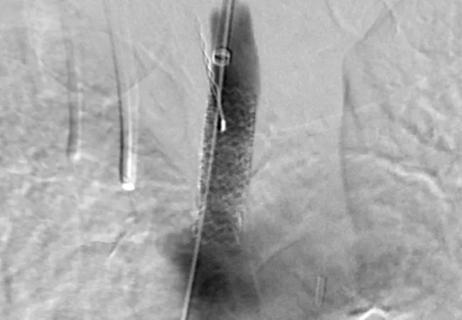An expert recap of a fast-moving clinical controversy

Cleveland Clinic is a non-profit academic medical center. Advertising on our site helps support our mission. We do not endorse non-Cleveland Clinic products or services. Policy
In the months since Katsanos and colleagues published their meta-analysis late last year in the Journal of the American Heart Association (JAHA) suggesting a safety signal with paclitaxel-coated devices for treating peripheral artery disease (PAD) in the femoropopliteal artery, it’s been a challenge to keep up with the evolving related developments.
The latest came March 15, when the FDA issued a letter to healthcare providers recommending that “alternative treatment options should generally be used for most patients” while the agency further evaluates data on the question.
Another key development was the March 1-2 Vascular Leaders Forum convened on this topic by Vascular Interventional Advances (VIVA), a not-for-profit organization focused on vascular medicine and intervention. As current President of VIVA and a participant in this forum, I have written this post to review the issue through the lens of that expert forum and advise colleagues on what to look for next in the use and regulation of paclitaxel-eluting stents and paclitaxel-coated balloons for treating PAD (collectively “paclitaxel-coated devices” hereafter).
Some 100 experts from across the globe were invited to the day-and-a-half Vascular Leaders Forum, including leaders of all pivotal clinical trials of approved paclitaxel-coated devices, regulatory officials from the FDA and Centers for Medicare & Medicaid Services, oncologists, vascular pathologists and others. The objective was to discuss all the relevant data to help understand the concern around paclitaxel-coated devices, particularly in view of the lack of any suggested plausible mechanism of harm, and to make recommendations on how to proceed.
After detailed sessions on PAD and mortality, the use of paclitaxel in other beds, and the basis for use of paclitaxel as a vascular antiproliferative agent, the forum turned to meta-analyses in general and the JAHA meta-analysis in particular, including a presentation on the latter by lead author Konstantinos Katsanos, MD, PhD, himself. Dr. Katsanos reviewed the methods and results of his group’s meta-analysis of 28 randomized controlled trials of paclitaxel-coated devices for PAD, including the finding of an increased rate of all-cause death at two years in claudicants receiving paclitaxel-coated devices with a potential dose-related signal.
Then came a review of potential limitations of the JAHA meta-analysis by William Gray, MD, of Lankenau Heart Institute, Boston, including:
Next came a session of reviews of CEC-adjudicated trial data from the pivotal trials of individual paclitaxel-coated devices. Leaders of trials for each of six such devices reviewed patient-level data for the respective devices — specifically, the Zilver PTX and Eluvia drug-eluting stents and the Ranger SFA, Lutonix, IN.PACT and Stellarex drug-coated balloons. I presented the review of the Stellarex data. Notably, from all individual data sets with patient-level data, no increased mortality signal was found across any of the studies.
This session also included a presentation on the THUNDER trial of an additional paclitaxel-coated balloon (Cotavance) that was included in the JAHA meta-analysis. The presentation noted that patients who had received the drug-coated balloon had longer and more aggressive follow-up than did their angioplasty counterparts, which potentially biased the results.
The next session explored regulatory reactions around the world, including suspension of recruitment for two ongoing European studies, BASIL 3 and Swede PAD, while two ongoing American studies, BEST and TRANSCEND, are continuing.
The final session focused on the path ahead, highlighting two upcoming data releases that clinicians may look to for clarification of the controversy:
Additionally, Peter Schneider, MD, reviewed a newly published patient-level meta-analysis he had just co-authored (J Am Coll Cardiol. 2019 Jan 25 [Epub ahead of print]) evaluating data from four independently adjudicated prospective studies comparing paclitaxel-coated balloons versus angioplasty in 1,980 patients with femoropopliteal artery disease. The analysis found no correlation between any level of paclitaxel exposure and mortality through five years.
The forum concluded with a panel discussion and audience polling. The latter revealed the following:
One final takeaway from the forum is worth noting: Many physicians and affected patients may still not be aware of this controversy. Even if they are, they may not be aware of the many nuances raised on both sides of the issue. The question is further clouded by the lack of any proposed causality for potential harm from paclitaxel coating in this setting.
So while we await more definitive data, it is our duty to explain the controversy in its fullness to our patients and colleagues, as well as to continue diligent monitoring of patients treated with paclitaxel-coated devices to date.
Dr. Lyden is Chair of Vascular Surgery at Cleveland Clinic.

How our first century has impacted cardiovascular practice

Review offers comprehensive assessment of the landscape for wearables and more

Preserving trust in research requires vigilance and consensus around statistical nuances

Cardiac surgeon Patrick Vargo, MD, reflects on his first year as Cleveland Clinic staff

Improved risk prediction for patients is at the heart of Dr. Aaron Weiss’ research interests

Centralization would likely bring better outcomes, experts say, but may not be feasible

Dr. Daniel Burns on mentorship, robotic valve surgery, statistics and more

JACC review makes the case and outlines how to ensure oversight